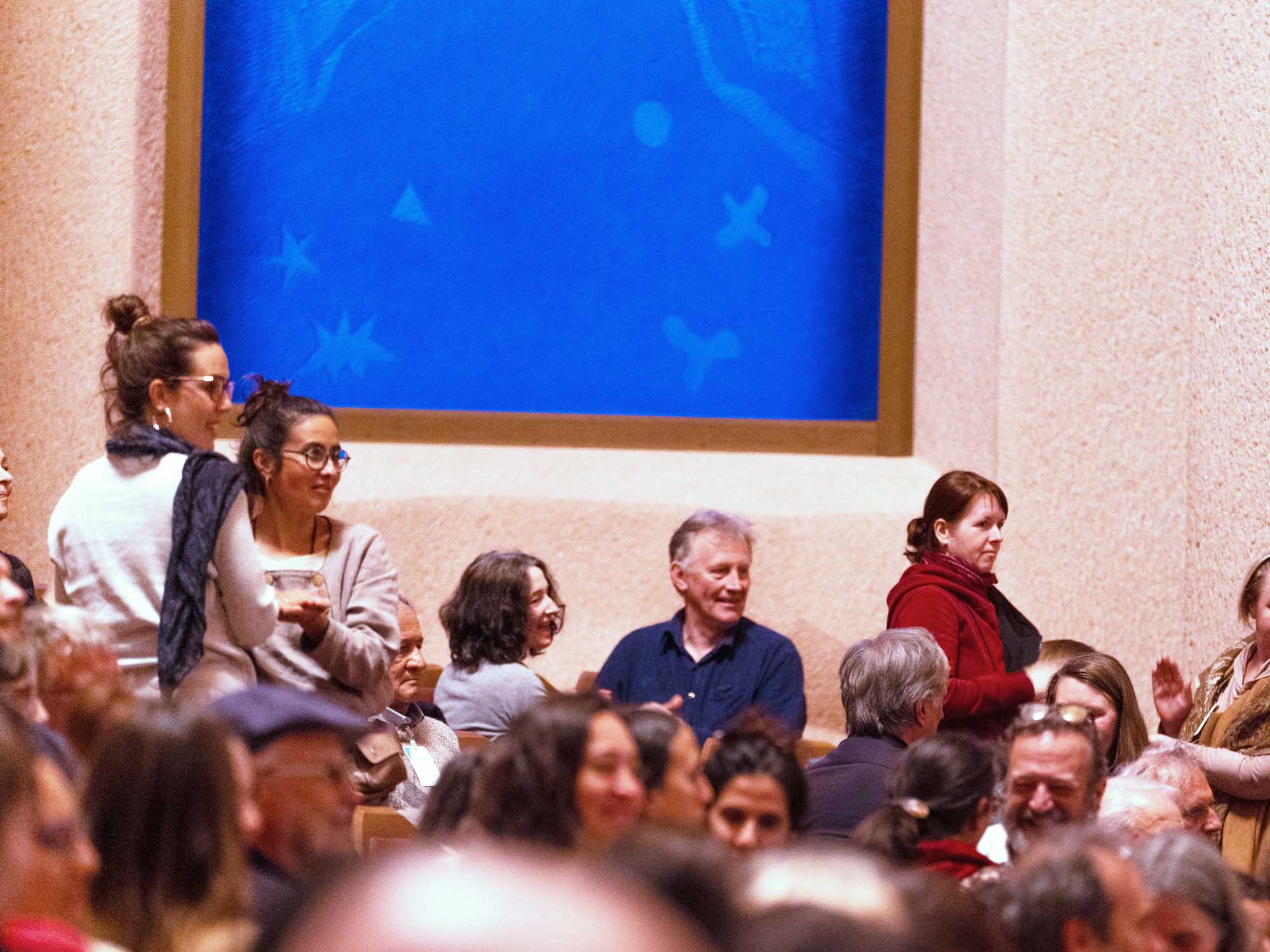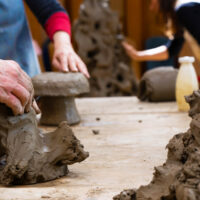It was a joyful celebration when the world came together at the Goetheanum—diverse and yet united in the will to shape the future of childhood.
Monday, 10 April, 8.30pm: 995 teachers and educators from 61 countries have just heard a lecture by the Spanish philosopher Josep Esquirol, when a man, dressed in a leather jacket, a telescope in hand, steps onto the stage. A group of flamboyantly attired ladies and gentlemen follow him, speaking several conference languages simultaneously. In the end, it becomes clear what they are saying: they want to get away from here, flee as fast as possible from problem-laden, polluted, boring planet Earth. Luckily, the man in the leather jacket can control spaceships with his telescope and soon they land on Mars, in another corner of the auditorium. This planet also soon loses its appeal and so they continue their journey until they realize, after their last flight accompanied by a movement from a Rachmaninov piano concerto: it is not the more or less agreeable conditions that make a place inviting, but love. In his own way, Esquirol had said something similar to what the young actors and eurythmists of the Goetheanum stage just performed: the invitation to assume responsibility in society is extended by teachers and educators who take the time to create a special place where they build a loving relationship with children and young people.
The Body We Are
Tuesday. Many languages are floating through the main auditorium again: English and Dutch form a strong melody with a sturdy Spanish accompaniment and a choir of Nordic tongues, interwoven with harmonies in Italian, French, Hungarian, Chinese and others, and a gentle duet of Russian and Ukrainian. Any German? A discrete basso continuo. Silence reigns before the lectures start. A young woman from the Netherlands is standing on the stage, silent. Then she starts to sing. Without a word, she gets the whole auditorium to sing.
Thomas Fuchs, professor for Philosophical Foundations of Psychiatry and Psychotherapy at Heidelberg University, speaks on the conference theme, using two concepts so distinctive that they keep coming up, again and again, throughout the conference, particularly in English translation. He explains the difference between the German word “Leib” (the enlivened body or “the body we are”) and “Körper” (the physical body or “the body we have”). Young children experience themselves unconsciously as a living unity of body and soul. They are all enlivened body and embodied presence. Once they have reached puberty, however, young people feel distinct from their physical body. It is a burden to them, something to hide or style. The body becomes a physical object that can become alien, that one changes and manipulates arbitrarily, like an object. This alienation from the physical body that has become something to be manipulated, a commodity, is something that education and self-education can work against. Spontaneous ways of being and “feeling at home in the earthly body” need to be consciously aspired to today.
But how? Wilfried Sommer, lecturer at the Kassel Waldorf Teacher Training, makes a proposal for science classes in high school. His lecture is detailed, precise, and concrete. It focuses on how experiments, descriptions of experiments, and the development of scientific concepts can be built on the bodily experience of early childhood and on young people’s sensory experiences.
Wholly Practical
Wednesday. There is more inspiration for daily pedagogical practice. Both speakers explain how the idea formulated generally by Thomas Fuchs can be applied in practice in kindergarten and grade school. Kathy MacFarlane, a Waldorf educator from New Zealand, speaks of an “attack on the rhythmic system” by the digital media and the measures introduced during the pandemic. By decelerating and simplifying the activities in kindergarten, by devoting time to carefully shaping the children’s surroundings, we can help them to breathe again and strengthen their life forces. Michal Ben Shalom, a grade teacher and lecturer from Israel, presents a philosophical, poetic, pedagogical praise of walking. So many children and young people arrive “at school straight from bed,” with hardly any physical exercise. Parents and teachers must use their imagination to find solutions, to find ways of walking every day. “Walking brings rhythm, deepens breathing, supports circulation, harmonizes the rhythmic system—our human center—and promotes life.” In one of the conversation groups that take place every morning after the lecture to discuss its content, someone says, “This lecture has come as a shock. I work in a city school where walking is unpleasant, unhealthy, and dangerous. Are my students and I condemned to ill-health?” Another conference member replies, “Think of last night, when the Hungarian students showed us Bothmer gymnastics: one could experience the beauty, strength, and ensoulment of the body, the joy of being at home in the body—and at the same time there was a meditative mood.” Others find that “eurythmy, gymnastics, music, language—all these activities we do in Waldorf Schools promote health and embodiment, so that the soul can express itself in the body.” “These conversation groups are the best: we can share our experiences, listen to each other, and gain a better understanding of the lectures.”
Casting a Light on the Future
History classes are there to accompany children and young people as they arrive in the here and now, and to cast a light from the past on what has become. That is not all however, for light also needs to be cast from the future, as Michael Zech from the teacher training in Kassel explains. And one should not only present narratives to the young people but enable them to formulate their own narrative. The most important task is not only to make the students aware of their own culture but to ensure that they “learn to become strangers in their own culture, finding a home while being on the way.”
Ya Chih, a eurythmist and former grade teacher from Taiwan, impresses us with her style of presentation which is very different from everything that went before. She talks about her life, and she shows and interprets the Chinese character for “Zen”: a pictogram, a request, a human ideal to connect the divine in the universe with the individual. According to Zen philosophy, a kind of lifelessness and lovelessness has taken hold of individual consciousness in the course of cultural evolution and has corrupted the human body. Christian tradition says that a “therapeutic source,” a seed for healing forces was planted in the human body through the death and resurrection of the Sun God. But conscious activation of the ‘I’ forces is needed to make these forces effective. In Zen philosophy one would say: one needs to make the effort to simultaneously practice waking up while enhancing the individual and forgetting oneself in the cosmic-spiritual life. “If someone else had said this or if it had been said at the beginning of the conference, we wouldn’t have been ready to open ourselves to such perspectives,” comments an Italian grade teacher after the lecture.
Other lectures focus on healing and therapy: Tomáš Zdražil (Freie Hochschule Stuttgart) speaks of nature, meaning, and community as pedagogical tools for planting forces of health for body and soul in the human being. Linda Williams (Detroit, USA) discusses intergenerational and intercultural solidarity, social structures, and the fostering of a sense that “I am because we are; we are because I am.” A refreshing dynamic can permeate the whole school when the feeling “I want to become the one who can awaken the others to themselves” can live among teachers, parents, and students.
Conclusion
“To experience the Waldorf movement in its reality as a global, diverse human community was like a shock, like waking up.” People experience and describe the tangible will to assume responsibility. Every school tries to put this into practice in its own way, in its own part of the world. However, some also say that more flexibility is needed, an opening for the moods and requirements of our time. Young teachers sometimes feel held back by older ones. At the conference, “We have experienced a less school-like form of school, a space for living, a place for social practicing and moral development.” Joy and enthusiasm permeate the conference and every encounter, “as if the Goetheanum was laughing,” as one participant puts it. “The world came together at the Goetheanum.” A big thank you from the Pedagogical Section to all who participated and contributed, to the organizers, and to the many helpers.
Translation Margot M. Saar
Photo Xue Li













